OAD-TOF system - Features
Innovative fragmentation technology
The OAD-TOF system is equipped with an OAD RADICAL SOURCE I, which enables Oxygen Attachment Dissociation (OAD) analysis, an innovative fragmentation that utilizes Shimadzu’s proprietary radical reaction. It can measure fragment ions that cannot be obtained by conventional collision-induced dissociation (CID), where ions are fragmented by collision with an inert gas such as argon or nitrogen. The irradiating oxygen radicals specifically oxidize/dissociate double bonds between carbons, which is useful for structure estimation of organic compounds such as lipids. The technique can be applied to monovalent ions and negative ions, which have been difficult to fragment using radical reactions by electrons and anions, and provides completely new structural information
What is OAD (oxygen attachment dissociation)
CID preferentially dissociates weak chemical bonds. In the case of lipids, CID can determine the basic structure of lipids and polar groups, and the carbon composition of side chains (number of carbons and double bonds). With OAD, on the other hand, oxygen radicals react specifically with the double bonds between carbons, causing dissociation. By measuring fragment ions specific to the double bond, the position of the double bond can be determined.
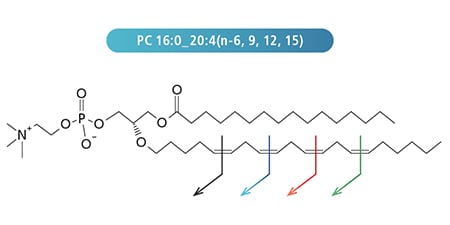
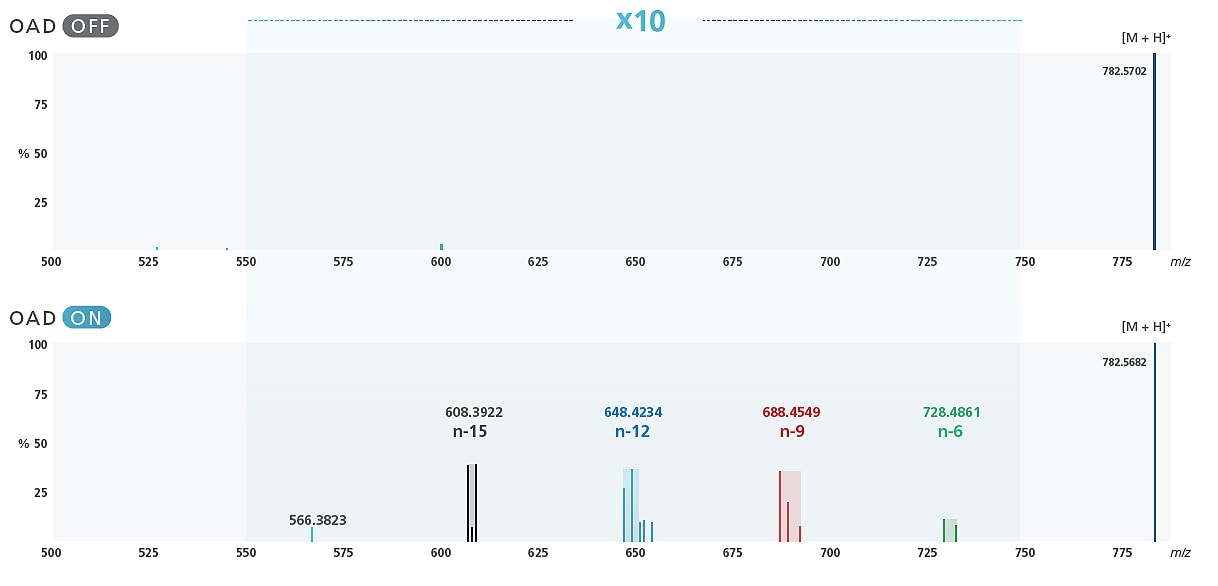
Innovative technologies to advance LCMS-9050
The LCMS-9050, renowned for its exceptional stability in mass accuracy and high-speed polarity switching, pairs perfectly with the OAD-TOF system. This combination allows for innovative applications and surpasses the known boundaries of mass spectrometry.
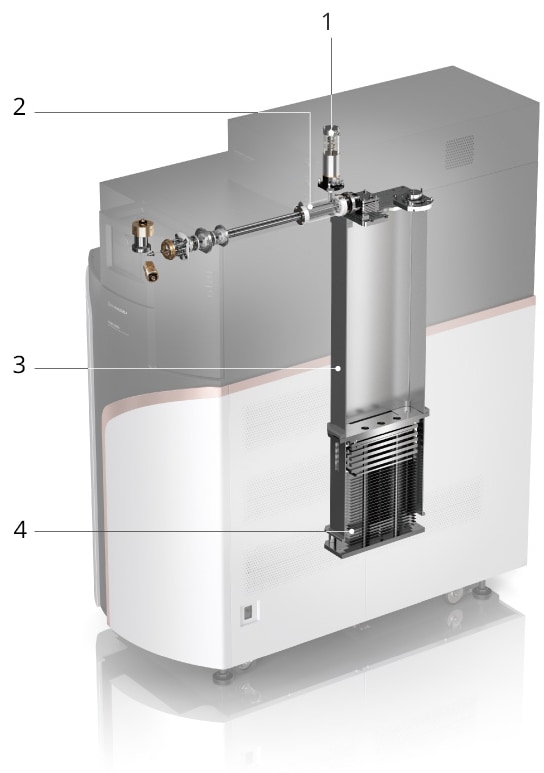
LCMS-9050
- Radical source
Neutral radicals such as O/OH/H radicals are generated by microwave discharge of raw material gases (water vapor and hydrogen gas) in a vacuum. The neutral radicals are introduced into the OAD cell through a quartz tube. - OAD cell
Precursor ions are reacted with neutral radicals generated in a radical source and fragmented. A collision gas (argon) can be introduced, and conventional CID fragmentation is also possible by setting the collision energy (CE). - UF-FlightTube™
Precise temperature control is achieved due to an optimized heater and heater sensor layout and a robust control system. This minimizes the effects of any room temperature variations to enable stable mass accuracy over long periods. It also reduces the time and trouble required for mass calibration. - iRef TOF™
The unique electrode shape achieves an ideal electric potential distribution that increases energy-focusing, while also inhibiting trajectory divergence and flight time lengthening during ion reflection.
Surprisingly simple
Easy to switch between CID and OAD
CID is also possible with the OAD RADICAL SOURCE I installed. No special software is required, and LabSolutions™ LCMS control and analysis software for LCMS-9050 can easily switch between OAD and CID for analysis. Acquisition of a large amount of structural information by OAD and CID can lead to new discoveries in lipids and other organic compounds.
Reliable structure estimation with high mass accuracy
The high mass accuracy achieved with the LCMS-9050 remains unchanged even with OAD. High-quality MS/MS data within ±3 ppm enables reliable structure estimation of compounds, including determination of the position of carbon-carbon double bonds.
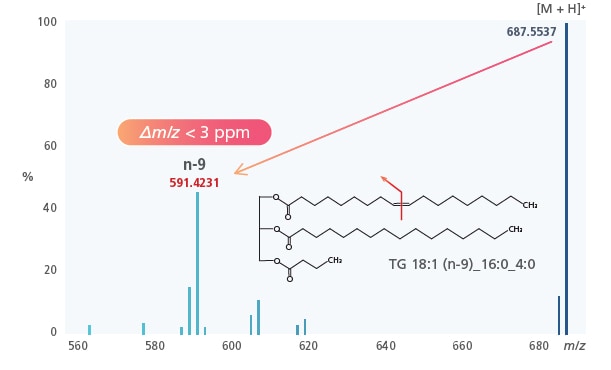
Creating endless possibilities
The OAD-TOF system can be used in combination with various options compatible with the LCMS-9050. The DPiMS™ QT, Kit for Direct Probe Ionization Mass Spectrometer, can be installed in place of the standard ESI unit for rapid analysis with simple pretreatment. It can also be connected to the Nexera™ UC supercritical fluid chromatography (SFC) system. This is especially useful for profiling lipids, where vast numbers of isomers exist.
DPiMS
Kit for Direct Probe Ionization Mass Spectrometer
Lipids in butter were analyzed using DPiMS in combination with the OAD-TOF system. Specific fragment ions derived from OAD were observed with only a simple pretreatment, which is a feature of DPiMS, and the double bond position of triacylglycerol was quickly estimated.
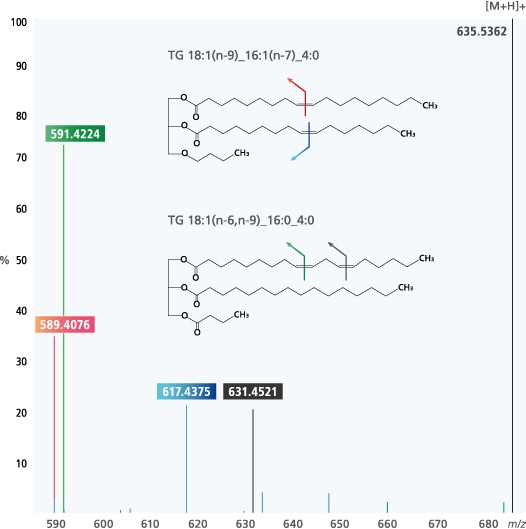
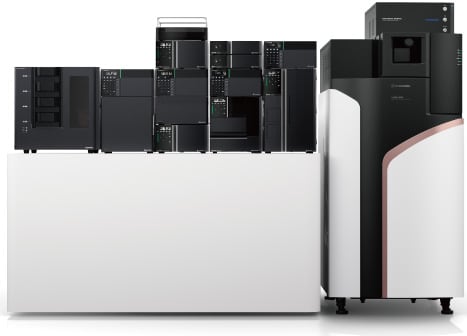
α-linolenic acid and γ-linolenic acid with different double bond positions were analyzed using Nexera UC and the OAD-TOF system. Isomers with similar structures were completely separated by SFC and detected with specific fragment ions derived from OAD, enabling highly accurate analysis. OAD can also be adapted to monovalent negative ions such as fatty acids.
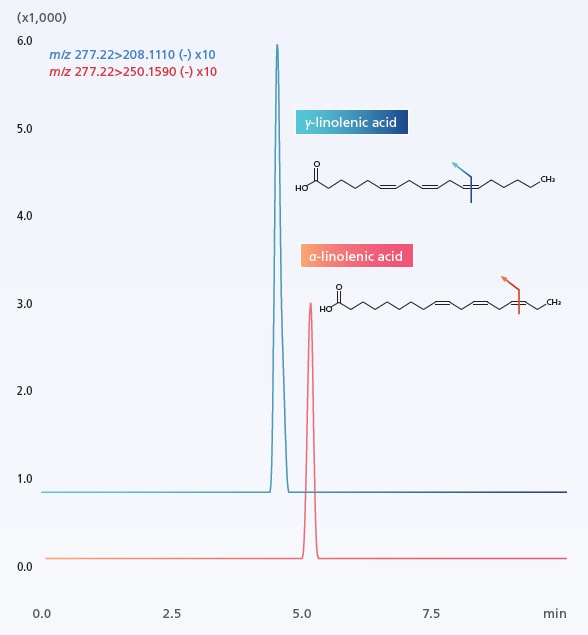
iRefTOF, UF-FlightTube, LabSolutions, DPiMS and Nexera are trademarks of Shimadzu Corporation or its affiliated companies in Japan and/or other countries.



